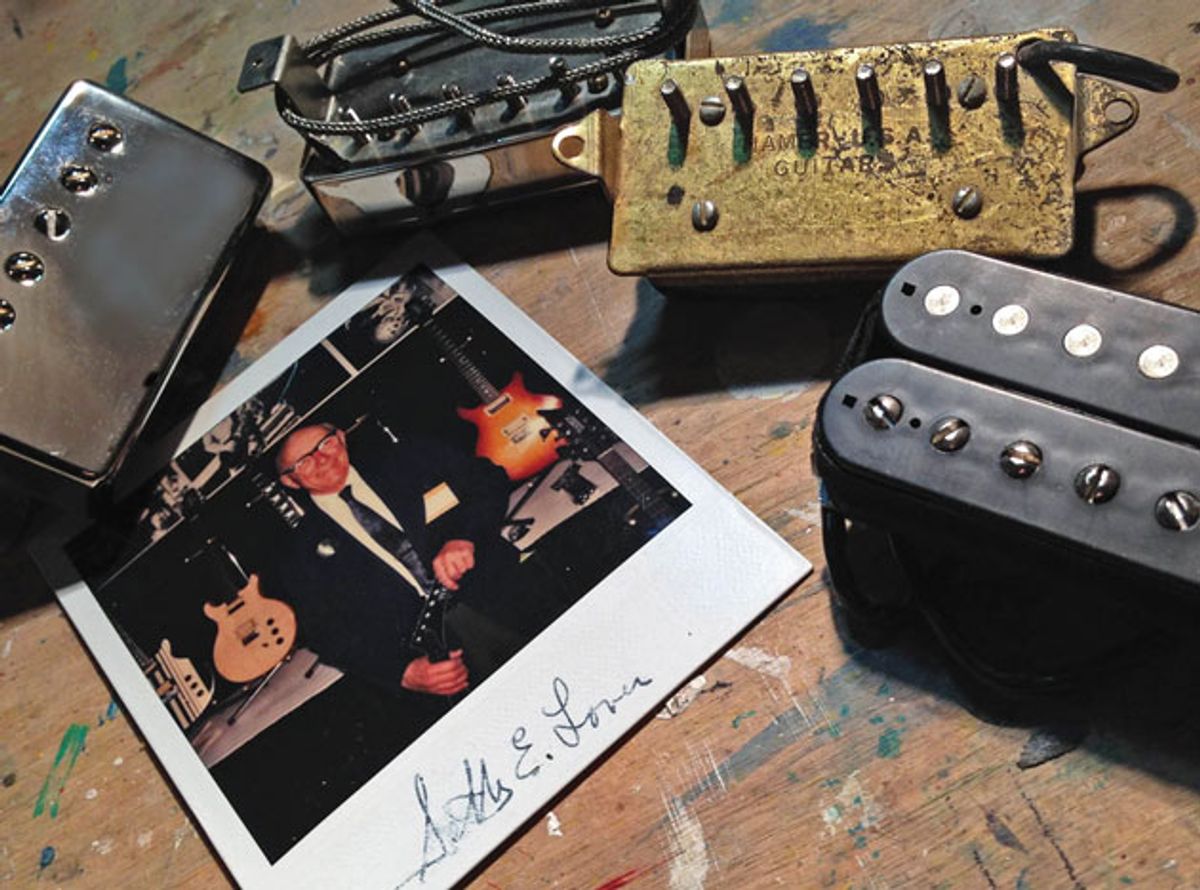
To expose or not to expose your humbuckers, and a little history behind the question.
I was recently asked why Hamer used cream- and zebra-colored humbuckers in many guitars. Because I’d taken the answer for granted for so long, I actually had to stop and think about it. The short answer is because we thought it looked cool. But that statement begs some backstory now that so much time has passed that the aesthetic history of guitars is, well, history. And the question coincides with another subject I’m also asked about: the significance or purpose of covered versus exposed coils.
Early electrics used pickups with a single coil, which were susceptible to interference from electrical fields generated by lighting, appliances, and even the guitar’s amplifier. To alleviate this bothersome buzzing, Seth Lover designed a double-coil hum-cancelling pickup in 1955 while employed at Gibson. Known colloquially as the “humbucker,” these pickups first appeared on Gibson 6-strings in 1957. For the first decade of their existence, these pickups were seen as shiny nickel- or gold-plated rectangular boxes with six slotted-fillister screw heads poking through the face. The internal coils and magnet were encased entirely by metal in order to shield the signal from RF (radio frequency) interference.
Back in the day, pickups were viewed as somewhat proprietary to each guitar maker and there weren’t aftermarket replacements. Most guitarists regarded pickups as a permanent part of the guitar, and not something to mess with.
Fast-forward to January 1965, when the Hollies’ guitarist Tony Hicks appeared on British television playing a cherry red Gibson ES-335 with the humbuckers’ pickup bobbins exposed to the world. Hicks’ instrument had previously been seen with its original gold covers, so it was my assumption they were removed after purchase. “Yes, I took the pickup covers off,” Hicks confirmed. “I left them off because I thought they looked better and they didn’t sound any different.”
Hicks’ countryman and fellow guitar-slinger Jeff Beck certainly took notice of this emerging trend. When Beck strolled onto the stage at Chicago’s Kinetic Playground with the Jeff Beck Group in 1968 and launched into their first number, I pushed my way forward to get a better look. Beck was playing a late-’50s Les Paul Standard that appeared to be fitted with four single-coil pickups. On closer examination, it turned out that the hot-rodding Beck-Ola had removed the nickel covers from his 9-year-old axe to reveal the guts within. Did he imagine some improvement was gained? It was hard to argue with the sound he was getting. I of course had to go home and take the covers off the humbuckers on my guitar too. Wouldn’t you? Before long, more rock guitarists like Marc Bolan, Robin Trower, and Alvin Lee were sporting the exposed-coil look.
Guitarists and techs who dared to pull apart the older PAF pickups found that the coil bobbins were mostly black, but sometimes they were cream colored. Combinations of cream/black or “double cream” occurred because—as the myth goes—the company that manufactured the parts for Gibson had run out of the black-plastic molding material, so Gibson used cream-colored material for a short while. After all, the coils were hidden, and no one would ever see them—or so it was assumed. It was completely random and didn’t change the sound, but the cream-bobbin pickups became coveted items because of rarity and fashion.
Still, the guitar-manufacturing industry—especially Gibson—was oddly oblivious to all of this. A short time after the Beck sighting when I was employed as a warranty technician at the Gibson factory in Kalamazoo, I mentioned that it would be a cool idea for Gibson to consider removing the covers on their pickups. “Bad idea,” I was told. “They could be damaged.”
Fashion aside, what does really happen when humbucker covers are removed? One ramification is that it allows the entire pickup to be raised (by the thickness of the cover) closer to the strings. This proximity results in increased output and a change in tonality as well.
Another aspect is the way the metal cover actually disrupts the magnetic field of the pickup. “One thing it does,” shares noted pickup builder Jason Lollar, “is smooth the attack out slightly. It gives a slight effect I’d call ‘grind’ to the tone, and it knocks off a little presence.” Additionally, Lollar finds that a cover can produce a variety of results depending on the material used and its thickness. This is borne out when studying the effects of eddy currents—small whirlpools of magnetism created in metal by fluctuating currents in a nearby coil. It’s part of the reason the Telecaster sounds the way it does, as the bridge pickup is surrounded by metal.
If you prefer the look or sound of covered pickups, it’s important for the cover to be fitted snugly on the bobbins. It’s interesting that the trend of removing covers from humbuckers in the 1960s paralleled the rise of amplifier wattage and volume. Players may have found that coverless coils mitigated uncontrollable squealing encountered on loud stages. According to Lollar, “If the cover is not seated correctly and soldered on, it will likely shriek like crazy in a nonmusical way from microphonic vibration if you get near your amp.”
So the answer to the original question is that not too long after the “bad idea” conversation at Gibson—when we were starting Hamer Guitars—we just naturally used that look on our instruments. We figured if it was cool enough for those British dudes, it was good enough for us, and Hamer became one of the first guitar companies to feature exposed-coil humbuckers. Of course, that look eventually became so ubiquitous, that I later decided to go retro-retro and put the covers back on our guitars! Everything old is new again, and again.
